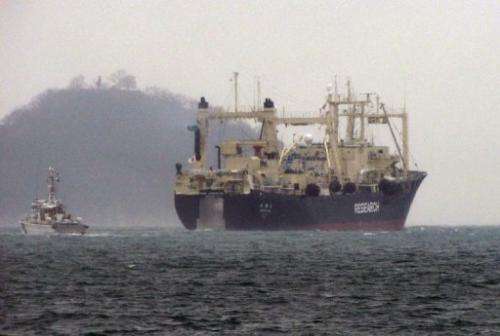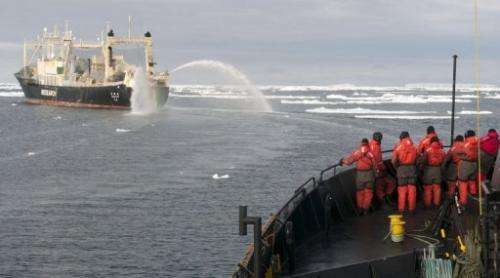Japan whaling fleet leaves port for Antarctica

Japanese whaling vessels left port Friday bound for the Southern Ocean on their annual hunt for the huge marine mammals, a media report and Greenpeace said.
Citing the Fisheries Agency, Kyodo News reported three vessels had departed from the far-western port of Shimonoseki, while environmental group Greenpeace said the whaling fleet's mother ship had left another port, also in the country's west.
"The mother ship, Nisshin Maru, left Innoshima today," said Greenpeace Japan's executive director Junichi Sato.
"Today was virtually the last day when they could leave for the Antarctic Sea," he said, adding that the fisheries agency had announced that the departure would take place within this month.
The mother ship would join the three vessels that left Shimonoseki earlier in the day, Kyodo said.
The fleet plans to hunt up to 935 Antarctic minke whales and up to 50 fin whales through March, the fisheries agency said earlier.
Japanese authorities refused to confirm either departure to AFP.
"We do not disclose when the vessels leave or left for safety reasons," an agency official said.

Coastguard officers will be aboard the ships to cope with possible harassment from anti-whaling activists, the coastguard and fisheries agency officials said earlier this month.
The fleet's departure comes weeks later than expected and days after a US court ordered militant environmental group Sea Shepherd to stay at least 500 yards (metres) from whaling vessels.
The injunction was ordered by the US Court of Appeals for the Ninth Circuit, in the latest step in a legal battle between the anti-whaling group and Japanese authorities over vessels in the Southern Ocean.
It said Sea Shepherd and Canadian militant conservationist Paul Watson, who is wanted by Interpol, "are enjoined from physically attacking any vessel engaged by plaintiffs", including Japan's Institute of Cetacean Research.
In addition, they are banned from "navigating in a manner that is likely to endanger the safe navigation of any such vessel", said the order, issued on Monday.
"In no event shall defendants approach plaintiffs any closer than 500 yards (460 metres) when defendants are navigating on the open sea," it added. The joint plaintiffs are Kyodo Senpaku Kaisha, Ltd., Tomoyuki Ogawa and Toshiyuki Miura.

It follows the issuing in August of an arrest notice by Interpol for Watson, Sea Shepherd's founder, who jumped bail in Germany in July.
He had been arrested there on charges from Costa Rica relating to a high-seas confrontation over shark finning in 2002.
In a statement on its website, Sea Shepherd called the new US court ruling "the first shot of the season" by Japanese whalers.
Confrontations between the whalers and activists have escalated in recent years, and the Japanese cut their hunt short in early 2011 due to Sea Shepherd harassment.
Japan hunts whales using a loophole in a global moratorium that allows killing the sea mammals for what it calls "scientific research", although the meat is later sold openly in shops and restaurants.
Watson, whose whereabouts had been a mystery since July, confirmed this month that he is back onboard a Sea Shepherd vessel and ready to confront Japanese whalers.
Sea Shepherd's ninth campaign, named Operation Zero Tolerance, is its largest ever against Japan's whale hunt and involves four ships, a helicopter, three drones and more than 100 crew members.
Three of the vessels, the Steve Irwin, Bob Barker and Brigitte Bardot, are all at sea while the Sam Simon is at an undisclosed location.
(c) 2012 AFP



















